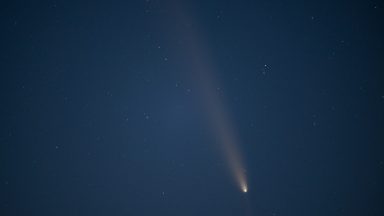
Stargazers have been in for quite a treat!
Comet Tsuchinshan-ATLAS, also known as C/2023 A3, has made its way to the Northern Hemisphere after appearing in the Southern Hemisphere over the weekend. It is currently shining at a magnitude of +0.5—well within the grasp of the human eye.
Here’s everything you need to know about this comet, which only comes around once every 80,000 years.
What Is Comet Tsuchinshan-ATLAS?
Comet Tsuchinshan-ATLAS is a long-period comet that was first discovered by astronomers using the Tsuchinshan Observatory in China. This comet is notable for its impressive return to the inner solar system, occurring only once every 80,000 years, which has earned it the nickname “comet of the century.” It is also the brightest of its kind since Comet NEOWISE, which was visible to the naked eye, even in large cities, back in 2020.
NASA describes comets as “cosmic snowballs of frozen gases, rock, and dust that orbit the sun.” As a comet’s orbit brings this “dirty snowball” close to the Sun, it heats up and ejects gases and dust, creating the appearance of a huge glowing head. A comet’s head can look as large or larger than many planets in the sky. The comet’s tail, composed of gases and dust, can stretch several million miles away from the sun; in the case of Comet Tsuchinshan-ATLAS, its tail is estimated to be around 18 million miles long.
When and How Can I See the Comet?
If you want to see this once-in-a-lifetime comet, time is running out.
Comet Tsuchinshan-ATLAS first appeared on Saturday, Oct. 12, and will be visible through the end of the month, according to NASA. However, as the days pass, the comet will appear dimmer and harder to see with the naked eye, as it moves higher in the sky each night, drifting away from the sun and out of the solar system.
Tonight, Oct. 17, may be particularly challenging for comet watchers due to the supermoon, which will wash out some of the comet’s tail. Still, it’s worth a look after sunset, said NASA’s Bill Cooke. “Most astronomers hate the full moon because its bright light interferes with observing other objects. So it’s a bit hard for us to wax poetic about it, even if it’s the biggest supermoon of 2024,” he noted in an email statement.
To catch a glimpse of the comet from the Northern Hemisphere, look west about 45 minutes after sunset; it will be just below and to the right of Arcturus, a bright red giant star in the constellation Boötes.

